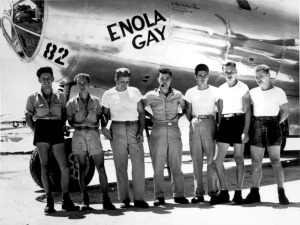
Wendover Field 1943 photo taken by Charles Westbrook

Crew of B-29 “Enola Gay” Col. Paul Tibbets center (photo courtesy Wikimedia.com)
Wendover’s mission was to train heavy bomb groups. The training of Boeing B-17 Flying Fortress and Consolidated B-24 Liberator groups began in April 1942. By late 1943 there were some 2,000 civilian employees and 17,500 military personnel at Wendover. For much of the war the installation was the Army Air Force‘s only bombing and gunnery range.
‘Bomb Trainer’ was the job title Charles Westbrook held there. He and another fellow named Poptonich were responsible for the bomb trainer building, to take care of the trainers and keep an eye on the bombardiers.
South of the main airbase and runways, a facility was built for development of the technology necessary to drop the first atomic weapons. These buildings were known as the “Technical Site”, and were located as far as possible from the rest of the base for security and also for safety in the event of an accident.
In September 1944. Boeing B-29 Superfortresses arrived on the field, as part of an operation code named “Silverplate”. They started preparations for the dropping of the world’s first atom bomb. Because of its remote location, Wendover Field was specifically chosen by Colonel Paul Tibbets as the training site for the crew of the Enola Gay to hone their skills for their infamous flight to deliver the Atomic bomb on Hiroshima. The Enola Gay was named for Tibbet’s mother.
Colonel Tibbets held the reputation of being the best pilot in the Air Force. President Dwight D. Eisenhower agreed that Tibbets was the man for the job. Charles had the honor of meeting Colonel Tibbets and the privilege of being in charge of the A-Bomb site vault while he was stationed at Wendover Field. Nobody, not even close relatives knew what type of work Charles was doing at the base until after the war was over.
This operation required utmost secrecy. The base was given the code name “Kingman” and the activity to assemble, modify and flight test prototype bombs was named “Project W-47”. Security was so intense, that 400 FBI agents were involved to help maintain it. Personnel were instructed to talk with no one about their activities, not even among themselves. Those who did were immediately transferred from Wendover to other assignments, some as far away as Alaska.
Crews were trained to drop one bomb with a high degree of precision, and to execute a sharp turn after dropping it in order to avoid the effects of the nuclear blast. The aircrews trained continuously for the classified mission until May 1945. In late April 1945, Colonel Tibbets declared the group combat ready and the ground echelon moved to its new home, North Field, Tinian, in the Marianas, on May 29 with the air echelon following on June 11.
Credits:
From Wikipedia, the free encyclopedia
References
- ^ “National Register Information System”. National Register of Historic Places. National Park Service. 2009-03-13.
- ^ 11 sites make new list of ‘endangered historic places’, at CNN.com
- ^ http://www.wendoverairbase.com/world_war_2 Wendover Air Base website (unofficial)
- ^ a b c Wendover Air Base website
- ^ Boyne, Walter J. (June 2007). “Project Paperclip” (PDF). AIR FORCE MAGAZINE, Journal of the Air Force Association (Air Force Association) 90 (6): 72.
 This article incorporates public domain material from websites or documents of the Air Force Historical Research Agency.
This article incorporates public domain material from websites or documents of the Air Force Historical Research Agency.- Maurer, Maurer (1983). Air Force Combat Units of World War II. Maxwell AFB, Alabama: Office of Air Force History. ISBN 0-89201-092-4.
- Thole, Lou (2003). Forgotten Fields of America, Volume III. Pictorial Histories Publishing Co. Inc ISBN 1-57510-102-5.

